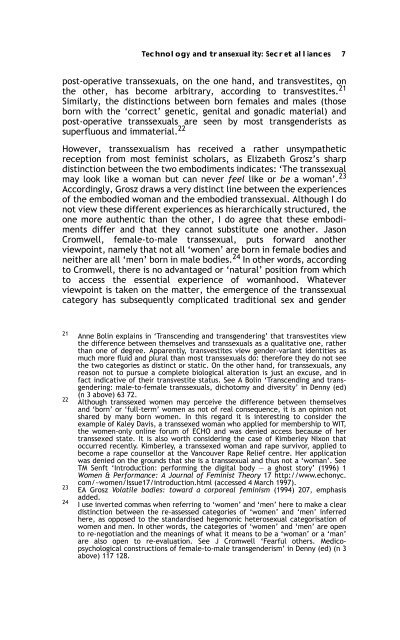Sex, Gender, Becoming - PULP
Sex, Gender, Becoming - PULP
Sex, Gender, Becoming - PULP
Create successful ePaper yourself
Turn your PDF publications into a flip-book with our unique Google optimized e-Paper software.
Technology and transexuality: Secret alliances 7<br />
post-operative transsexuals, on the one hand, and transvestites, on<br />
the other, has become arbitrary, according to transvestites. 21<br />
Similarly, the distinctions between born females and males (those<br />
born with the ‘correct’ genetic, genital and gonadic material) and<br />
post-operative transsexuals are seen by most transgenderists as<br />
superfluous and immaterial. 22<br />
However, transsexualism has received a rather unsympathetic<br />
reception from most feminist scholars, as Elizabeth Grosz’s sharp<br />
distinction between the two embodiments indicates: ‘The transsexual<br />
may look like a woman but can never feel like or be a woman’. 23<br />
Accordingly, Grosz draws a very distinct line between the experiences<br />
of the embodied woman and the embodied transsexual. Although I do<br />
not view these different experiences as hierarchically structured, the<br />
one more authentic than the other, I do agree that these embodiments<br />
differ and that they cannot substitute one another. Jason<br />
Cromwell, female-to-male transsexual, puts forward another<br />
viewpoint, namely that not all ‘women’ are born in female bodies and<br />
neither are all ‘men’ born in male bodies. 24 In other words, according<br />
to Cromwell, there is no advantaged or ‘natural’ position from which<br />
to access the essential experience of womanhood. Whatever<br />
viewpoint is taken on the matter, the emergence of the transsexual<br />
category has subsequently complicated traditional sex and gender<br />
21<br />
Anne Bolin explains in ‘Transcending and transgendering’ that transvestites view<br />
the difference between themselves and transsexuals as a qualitative one, rather<br />
than one of degree. Apparently, transvestites view gender-variant identities as<br />
much more fluid and plural than most transsexuals do: therefore they do not see<br />
the two categories as distinct or static. On the other hand, for transsexuals, any<br />
reason not to pursue a complete biological alteration is just an excuse, and in<br />
fact indicative of their transvestite status. See A Bolin ‘Transcending and transgendering:<br />
male-to-female transsexuals, dichotomy and diversity’ in Denny (ed)<br />
(n 3 above) 63 72.<br />
22 Although transsexed women may perceive the difference between themselves<br />
and ‘born’ or ‘full-term’ women as not of real consequence, it is an opinion not<br />
shared by many born women. In this regard it is interesting to consider the<br />
example of Kaley Davis, a transsexed woman who applied for membership to WIT,<br />
the women-only online forum of ECHO and was denied access because of her<br />
transsexed state. It is also worth considering the case of Kimberley Nixon that<br />
occurred recently. Kimberley, a transsexed woman and rape survivor, applied to<br />
become a rape counsellor at the Vancouver Rape Relief centre. Her application<br />
was denied on the grounds that she is a transsexual and thus not a ‘woman’. See<br />
TM Senft ‘Introduction: performing the digital body — a ghost story’ (1996) 1<br />
Women & Performance: A Journal of Feminist Theory 17 http://www.echonyc.<br />
com/~women/Issue17/introduction.html (accessed 4 March 1997).<br />
23 EA Grosz Volatile bodies: toward a corporeal feminism (1994) 207, emphasis<br />
added.<br />
24<br />
I use inverted commas when referring to ‘women’ and ‘men’ here to make a clear<br />
distinction between the re-assessed categories of ‘women’ and ‘men’ inferred<br />
here, as opposed to the standardised hegemonic heterosexual categorisation of<br />
women and men. In other words, the categories of ‘women’ and ‘men’ are open<br />
to re-negotiation and the meanings of what it means to be a ‘woman’ or a ‘man’<br />
are also open to re-evaluation. See J Cromwell ‘Fearful others. Medicopsychological<br />
constructions of female-to-male transgenderism’ in Denny (ed) (n 3<br />
above) 117 128.
















